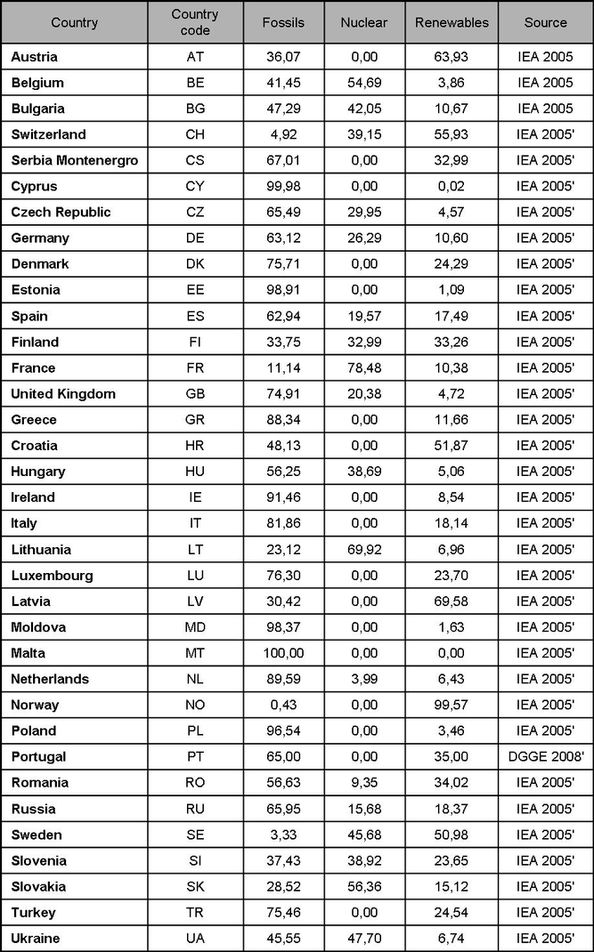APPENDICES
Aus Display Documentation in German
(→Classification for the water ratio:) |
(→Conversion factors for district heat (used by default)) |
||
| (Der Versionsvergleich bezieht 34 dazwischenliegende Versionen mit ein.) | |||
| Zeile 6: | Zeile 6: | ||
Currently, 11 types of buildings can be classified. The classification scheme could change in the future.<br/> | Currently, 11 types of buildings can be classified. The classification scheme could change in the future.<br/> | ||
| - | ===<u>'''Classification scheme for the primary energy ratio | + | ===<u>'''Classification scheme for the primary energy ratio'''</u>=== |
| - | [[Image: | + | [[Image:Classification_for_the_primary_energy_ratio.jpg]]<br/> |
| - | + | ||
| - | ===<u>'''Classification scheme for the CO2 ratio | + | ===<u>'''Classification scheme for the CO2 ratio'''</u>=== |
| - | [[Image: | + | [[Image:Classification_for_the_CO2_ratio.jpg]]<br/> |
| - | + | ||
| - | ===<u>'''Classification for the water ratio | + | ===<u>'''Classification for the water ratio'''</u>=== |
| - | + | [[Image:Classification_for_the_water_ratio.jpg]]<br/> | |
| - | [[Image: | + | |
| - | + | ||
===Conversion Factors and their Sources<br/>=== | ===Conversion Factors and their Sources<br/>=== | ||
| - | ===<u>'''General conversion factors | + | ===<u>'''General conversion factors'''</u>=== |
[[Image:Wood.jpg]]<br/> | [[Image:Wood.jpg]]<br/> | ||
| - | |||
| - | ===<u>'''Conversion factors for final energy use | + | ===<u>'''Conversion factors for final energy use'''</u>=== |
[[Image:Natgaz.jpg]]<br/> | [[Image:Natgaz.jpg]]<br/> | ||
| - | |||
| - | ===<u>'''Conversion factors for generation of electricity (average national electricity production) | + | ===<u>'''Conversion factors for generation of electricity (average national electricity production)'''</u>=== |
| - | [[Image: | + | [[Image:Table7 conversion factors Energy CO2.jpg]]<br/> |
| - | + | ||
| - | ===<u>'''Conversion factors for generation of electricity (specified energy sources) | + | ===<u>'''Conversion factors for generation of electricity (specified energy sources)'''</u>=== |
| + | '''Conversion factors for generation of electricity'''<br/> | ||
| + | [[Image:Enrsources.jpg]]<br/> | ||
| - | + | '''Energy mix by country'''<br/> | |
| - | ''' | + | [[Image:Table_8__Energy_Mix_2005_en_actu.jpg]]<br/> |
| - | [[Image: | + | |
| - | + | ||
| - | ===<u>'''Conversion factors for district heat (used by default) | + | ===<u>'''Conversion factors for district heat (used by default)'''</u>=== |
[[Image:Primaryener.jpg]]<br/> | [[Image:Primaryener.jpg]]<br/> | ||
| - | |||
Aktuelle Version vom 09:54, 16. Sep. 2010
The Classification Scheme
The Danish classification, used since 1996, is the base of the Display® classification schemes. So far the Danish scheme, taking into account a building typology, is the only classification all over Europe.
By increasing the number of registered buildings in the different types and considering the recommendations of the CEN (Normalization European Comity), an iterative approach allowed to adjust the classification schemes after the first 6 test months.
Furthermore, the classification scheme will take into account the information provided by the Concerted Action, a working group composed of representatives from nearly all EU member states. The objective of the CA working group is the harmonisation of the implementation of the Energy Performance of Buildings Directive.
Currently, 11 types of buildings can be classified. The classification scheme could change in the future.
Classification scheme for the primary energy ratio
Classification scheme for the CO2 ratio
Classification for the water ratio
Conversion Factors and their Sources
General conversion factors
Conversion factors for final energy use
Conversion factors for generation of electricity (average national electricity production)
Conversion factors for generation of electricity (specified energy sources)
Conversion factors for generation of electricity









